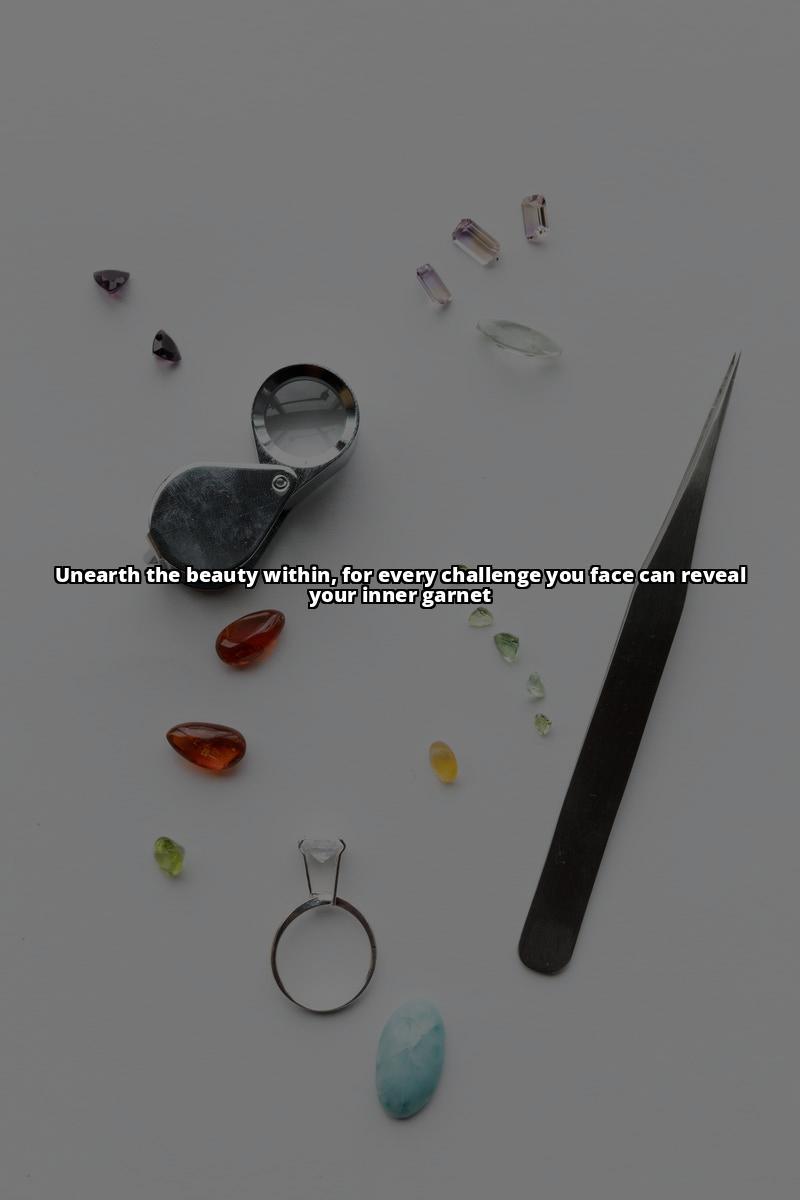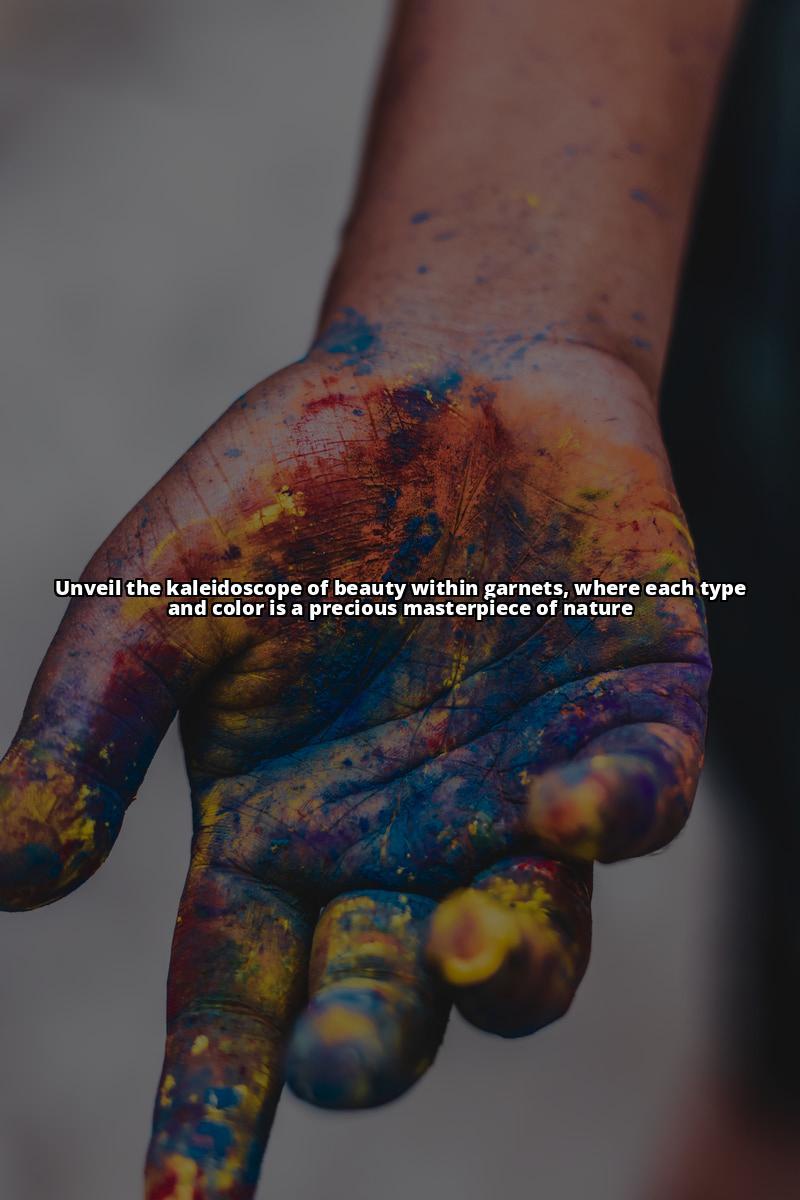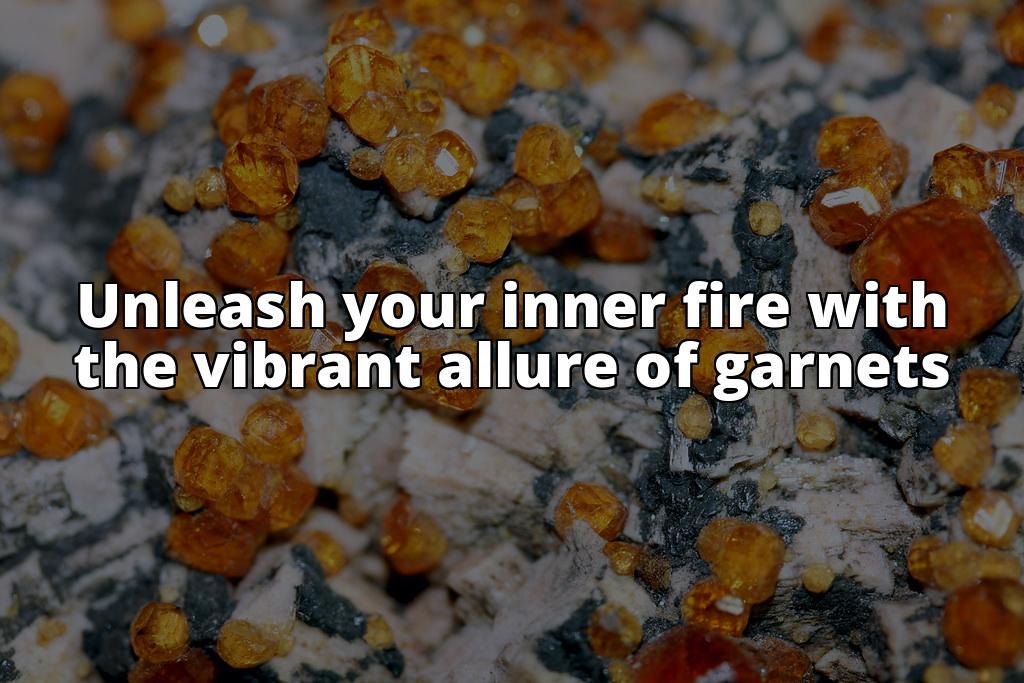What you will learn about garnet gemstones:
- Formation and geological occurrence of garnets, including the different settings and factors that influence their formation.
- Types and colors of garnets, exploring the different species and the range of colors they can exhibit.
- Uses and applications of garnets, both in jewelry and in industrial and technological fields.
Garnets are a group of silicate minerals that have been used as gemstones and abrasives since ancient times. They come in different species and colors, with reddish shades being the most common. Garnets have unique physical and magnetic properties, and their chemical composition varies among different species. They are found in various geological formations and have a range of uses in industries such as jewelry, lasers, and industrial applications. They are also important in geology for studying metamorphism and dating geologic events.

Formation and Geological Occurrence:
Garnets are formed in different geological settings, including metamorphic rocks, igneous rocks, and alluvial deposits. In metamorphic rocks, such as schist and gneiss, garnets are formed under high temperature and pressure conditions. They can also be found in igneous rocks like granite, where they crystallize from magma. Alluvial deposits, such as riverbeds and beaches, can also yield garnets that have been eroded from their original source rocks.
The formation of different garnet species and colors is influenced by several factors. These include the chemical composition of the parent rock, the temperature and pressure conditions during formation, and the presence of specific elements and impurities. For example, the presence of iron and magnesium in the parent rock can result in the formation of Almandine and Pyrope garnets, while the presence of manganese can lead to the formation of Spessartine garnets.
Notable garnet deposits can be found around the world, each with its own significance and commercial value. For instance, the Bohemian garnet mines in the Czech Republic have been a major source of high-quality garnets for centuries. Other significant deposits exist in India, Sri Lanka, Brazil, and the United States. The Pyrope garnets from Bohemia and the Rhodolite garnets from East Africa are particularly renowned for their deep red color and exceptional clarity.

Types and Colors:
Garnets encompass a variety of species, each with its own unique characteristics. Some of the most well-known species include Almandine, Pyrope, Spessartine, Grossular, Andradite, and Uvarovite. Almandine garnets are known for their deep red to reddish-brown color, while Pyrope garnets exhibit a vibrant red color. Spessartine garnets can range from orange to reddish-brown, and Grossular garnets can be green, yellow, or brown. Andradite garnets come in various colors, including yellow, green, and black, while Uvarovite garnets are known for their intense green hue.
The color of a garnet is influenced by the presence of trace elements and impurities within its crystal structure. For example, the presence of iron can give garnets a reddish color, while the presence of chromium can result in a vivid green color. The intensity and saturation of the color can also vary depending on the concentration of these elements. Additionally, some garnets may exhibit color-change phenomena, appearing different colors under different lighting conditions.

Uses and Applications:
Garnets have a long history of use as gemstones in jewelry. Their rich colors and excellent durability make them a popular choice for various types of jewelry, including rings, necklaces, earrings, and bracelets. They have been used in jewelry throughout different cultures and time periods, from ancient civilizations to modern-day fashion trends. Garnets are also associated with January birthstones and are often given as gifts to celebrate second wedding anniversaries.
Apart from their use in jewelry, garnets have numerous industrial applications. Due to their hardness and abrasive properties, they are widely used in the production of abrasives for sandblasting, waterjet cutting, and polishing. Garnet abrasives are highly effective in removing unwanted materials from surfaces without causing damage. Additionally, garnets are used in the manufacturing of specialized cutting tools, such as diamond saw blades and grinding wheels.
In the field of technology, garnets play a crucial role in laser technology and optics. Certain types of garnets, such as Yttrium Aluminium Garnet (YAG), are used as laser crystals in various applications, including medical lasers, industrial lasers, and scientific research. Garnets are also used in optical instruments, such as lenses and prisms, due to their high refractive index and excellent light transmission properties.

Identification and Grading:
When evaluating the quality and value of garnets, several criteria are considered. These include color, clarity, cut, and carat weight. The color of a garnet is one of the most important factors, with intense and vibrant colors being highly desirable. Clarity refers to the presence of any inclusions or imperfections within the gemstone, with higher clarity grades being more valuable. The cut of a garnet determines its overall shape and faceting, which can greatly enhance its brilliance and sparkle. Finally, carat weight refers to the size and weight of the garnet, with larger stones generally being more valuable.
Gemologists use various gemological properties and characteristics to identify garnets. These include refractive index, which measures how light bends as it passes through the gemstone, and hardness, which refers to a gemstone’s resistance to scratching. Specific gravity, which compares the weight of the gemstone to the weight of an equal volume of water, is another important property used for identification. Other tests, such as color filters and spectroscopy, may also be employed to determine the specific type of garnet.
It’s worth noting that certain treatments, such as heat treatment and irradiation, may be applied to enhance the color or clarity of garnets. These treatments are considered acceptable in the gem trade as long as they are properly disclosed. However, treated garnets may have different grading considerations compared to untreated stones.

Care and Maintenance:
To ensure the longevity and beauty of garnet gemstones, proper care and maintenance are essential. It is recommended to store garnet jewelry in a soft pouch or a separate compartment to avoid scratching or damage from other jewelry. Harsh chemicals, such as bleach or abrasive cleaning agents, should be avoided when cleaning garnets, as they can cause damage to the stone. Instead, gentle cleaning with warm soapy water and a soft brush is usually sufficient.
Different types of garnets may have specific considerations for care and maintenance. For example, some garnets may be more prone to scratching than others due to variations in hardness. It is important to consult with a professional jeweler or refer to specific care instructions for the type of garnet jewelry you have.
For valuable or antique garnet jewelry, it is recommended to have them professionally cleaned and inspected periodically. Professional jewelers have the expertise and tools to carefully clean and restore the beauty of garnet gemstones, while also ensuring the integrity of the setting and any surrounding diamonds or gemstones.
| Interesting Facts | Mythological Associations |
|---|---|
| Garnets are associated with the month of January and are considered the birthstone for January-born individuals. | Ancient civilizations believed that garnets had the ability to ward off evil spirits and protect against harm. |
| Garnets are also associated with the zodiac sign Aquarius. | Garnets were believed to possess healing properties and were used to treat various ailments and diseases. |
| Garnets are often considered the gemstone for second wedding anniversaries, symbolizing love, devotion, and commitment. | |
| The Russian Crown Jewels feature several impressive garnets, including the famous “Pyrope Bohemian” garnet, which weighs over 250 carats. | |
| The Smithsonian Institution in Washington, D.C. houses a collection of stunning garnets, including the “Emperor Maximilian” garnet, one of the largest garnets ever discovered. |
Personal Story: The Time I Discovered the Hidden Beauty of Garnet Jewelry
One day, while strolling through a local jewelry store, I stumbled upon a display of stunning garnet jewelry that immediately caught my eye. The deep red hues of the gemstones seemed to radiate warmth and elegance, drawing me in like a magnet. As I held a garnet necklace in my hands, I couldn’t help but be captivated by its beauty and uniqueness.
Curiosity piqued, I began to delve deeper into the world of garnets. I learned that garnets are not just any ordinary gemstone; they have a rich history dating back to ancient times. In fact, they were often used by ancient civilizations as symbols of protection and power. This historical significance only added to my fascination with these captivating jewels.
As I continued my research, I discovered the wide variety of colors and species that garnets can exhibit. From fiery red Almandine to vibrant green Uvarovite, each species had its own distinct charm and allure. I was amazed to learn that garnets are not limited to the classic red shade that is commonly associated with them. This newfound knowledge opened my eyes to the endless possibilities of garnet jewelry.
Not only are garnets aesthetically pleasing, but they also have practical uses. I was surprised to discover that garnets are widely used in industrial applications, such as waterjet cutting and sandblasting. Their hardness and durability make them ideal for these purposes, showcasing their versatility beyond the realm of jewelry.
Armed with my newfound appreciation for garnets, I couldn’t help but incorporate them into my own personal style. I purchased a stunning garnet ring that quickly became one of my favorite pieces of jewelry. Its deep red color adds a touch of sophistication to any outfit, making it a true statement piece.
My journey into the world of garnets has not only deepened my understanding of these captivating gemstones but also enriched my appreciation for the artistry and craftsmanship that goes into creating garnet jewelry. I now find myself constantly on the lookout for new garnet pieces to add to my collection, forever mesmerized by their timeless beauty and allure.
Interesting Facts and Mythology:
Garnets have various interesting facts and mythological associations that add to their allure. They are traditionally associated with the month of January and are considered the birthstone for those born in that month. Garnets are also associated with the zodiac sign Aquarius. In addition, garnets are often considered the gemstone for second wedding anniversaries, symbolizing love, devotion, and commitment.
In mythology and folklore, garnets have been attributed with various qualities and powers. Ancient civilizations believed that garnets had the ability to ward off evil spirits and protect against harm. It was widely accepted that garnet could signal approaching danger by turning pale. In medieval times, garnets were believed to possess healing properties and were used to treat various ailments and diseases.
Famous garnets can be found in royal jewelry and renowned gem collections. For example, the Russian Crown Jewels feature several impressive garnets, including the famous “Pyrope Bohemian” garnet, which weighs over 250 carats. The Smithsonian Institution in Washington, D.C. also houses a collection of stunning garnets, including the “Emperor Maximilian” garnet, which is one of the largest garnets ever discovered.
Conclusion:
In conclusion, garnet gemstones are captivating jewels with a rich history and a range of unique properties. From their formation in different geological settings to their various species and colors, garnets offer a diverse array of options for gemstone enthusiasts and jewelry lovers. Their use in jewelry spans across cultures and time periods, while their industrial applications and technological uses demonstrate their versatility and practicality. With their beauty, durability, and historical significance, garnets continue to be cherished gemstones with enduring appeal.
So, whether you’re drawn to the deep red hues of Almandine and Pyrope garnets or the vibrant green of Uvarovite, exploring the world of garnets is sure to be a fascinating journey. From the royal treasures of the past to the modern designs of today, garnets hold a special place in the world of gemstones and continue to captivate with their timeless beauty.
For more information about garnets and their fascinating properties, you can refer to the Garnet – Wikipedia page. Additionally, the GIA (Gemological Institute of America) website provides comprehensive information about garnets, including their identification and grading.
Questions and Answers
What is a garnet gemstone?
Garnet is a precious gemstone known for its deep red color and brilliance.
Who can wear garnet gemstones?
Anyone can wear garnet gemstones as they are believed to bring good luck and protection.
How can I clean my garnet gemstone?
Clean your garnet gemstone using warm soapy water and a soft brush, then rinse and dry it gently.
What are the different types of garnet gemstones?
There are several types of garnet gemstones, including almandine, pyrope, spessartine, and grossular.
How can garnet gemstones benefit me?
Garnet gemstones are believed to enhance energy, promote self-confidence, and provide protection against negative energies.
But aren’t garnet gemstones expensive?
While rare varieties of garnet can be expensive, there are affordable options available, making it accessible to everyone.






